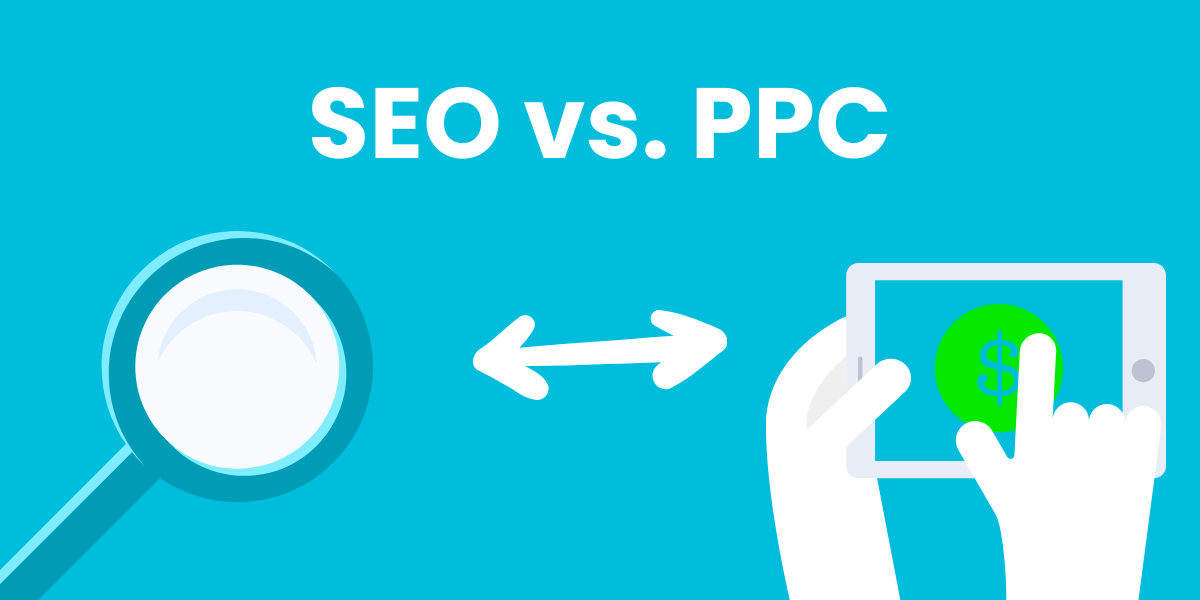You may ask yourself: “SEO or PPC – which is better for me?” There is no general answer to that question – but wait, one answer is available: “There is no either/or! ” That said, both SEO and PPC are good tools to help your business grow. But it depends on your business. Your product or service, your business situation and condition will answer the question when to use SEO and when to use PPC. The best way is to use them both. Use them both in integrated and aligned techniques.
There are differences between both channels that you might consider in view of your business.
SEO Brings Organic Long Term Traffic to Your Business Website
SEO brings organic traffic to your website in the long term. SEO means to optimize your content, use backlinks and technical tweaks on your website in order to obtain the right people traffic to the right page on your website. But as said, SEO is a long term job that needs investment in the beginning but brings you a good return on investment (ROI). As you can see in the following illustration, you have to invest a lot of time and money in the beginning. You will get very little traffic at the start. But done right, you efforts will pay out after a while – so don’t give up 😉
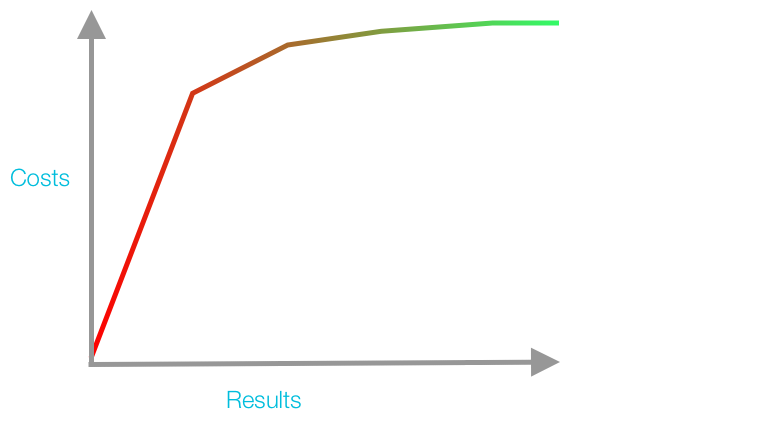
Keep in mind that organic SEO needs a wider range of measurements to do it correctly and get a good ROI.
SEO Works Best for Informational Intended Searches and Content
Most organic content appears to be informational and branded content to meet the requirements for an informational intent search. When someone conducts a search with a specific request, they mostly click on informational or branded content.
Informational content is content that helps answer a question a user has in mind. It “informs” them about something. Looking at a marketing funnel, informational content is good to bring potential clients closer to a given product or service. It informing them via blog posts, etc. about the benefits of using them. With this approach you can target a wide range of potential clients, that aren’t aware of your product. Nearly every professional blog is setup to obtain this kind of traffic – when done well.
When we talk about branded content, someone was searching for your companies name or one of your products name. Where as an informational intent search query mostly isn’t targeted to any specific company or brand from the user’s perspective. A branded search query means, that the user may have had a hint about a brand, product or a company before.
The following illustration shows a result after an informational intent search. Someone who is searching for an answer “what is an ink cartridge” assuming they do not have a commercial but an informational intent at this point. Here you can see that there are no ads!
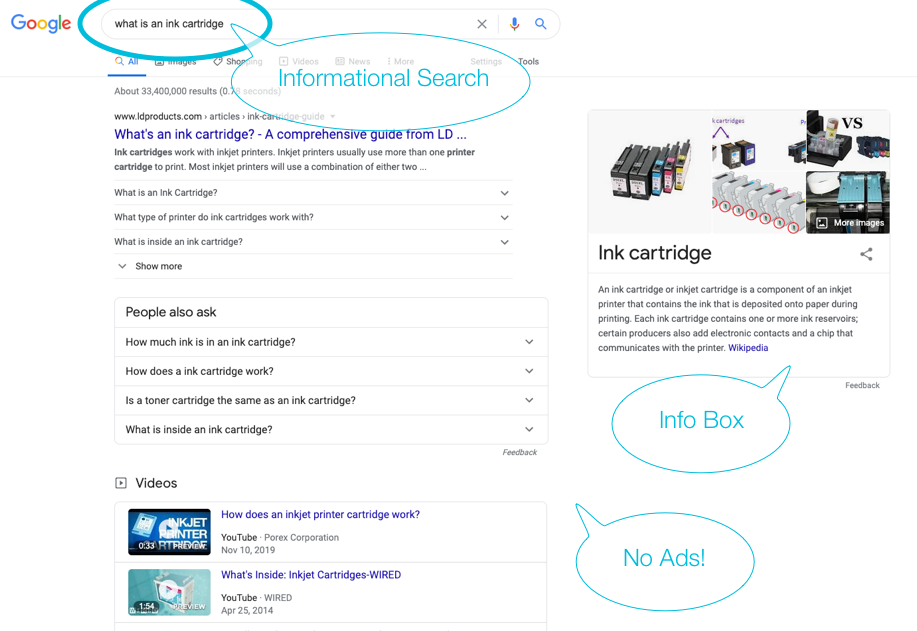
So, SEO is very approprite (but not only) for early funnel stages. Someone is requesting information on a product or service in order to make a decision, whether to buy or not, where to buy and what variant to buy. Informational intent searches are located in the consideration state of a sales funnel.
Advantages with SEO
Awareness: With organic SEO you can greatly improve your sustainable visibility over the long term!
Website Traffic: Generate more website traffic in order to drive attention to your business. Filter this traffic using a website analytics tool to cluster them into audiences and retarget them using display ads. You may also improve your websites UI/UX by analyzing the user’s behavior using search traffic.
Sustainability: Unlike PPC, organic traffic does not stop to flow the moment you stop paying for it. Organic traffic is insensitive for marketing budgets up and downs. Your traffic will remain stable at least for a while.
Strategic Leap: From the time your website is well positioned on SERPs it will be more difficult for your competitor to tune in on similar search queries. They then need to compete with cost intensive PPC to be kept in the race with you.
Click Through Rates (CTR): When done right, you can obtain very good click through rates (CTR) with your organic pages. The closer a title and a description of a result is to the search query and search intent are, the higher a CTR can be. CTRs can be very high when optimizing your web pages for long tail keywords.
PPC Brings Short Term Quality Traffic – Fast and Direct!
PPC is like using a sniper rifle it is more accurate in hitting a target. Where as SEO is like a shotgun that spreads your messages or services over many web result pages.
With PPC you’re able to target on very specific search queries using a very specific ad and landing page to lead your potential clients to you website.
On search engine result pages, PPC ads are shown up on top of all organic results. This is a huge advantage on awareness, visibility and reach for a given keyword.
Opposite to organic traffic, PPC is payed per click. That means you need to pay for every click done on your search ad – despite if it was a good, intentional or bad an unintentional click. On a long term, the cost for traffic is higher than organic traffic obtained by SEO. But it brings you quality traffic fast and direct – when done right.
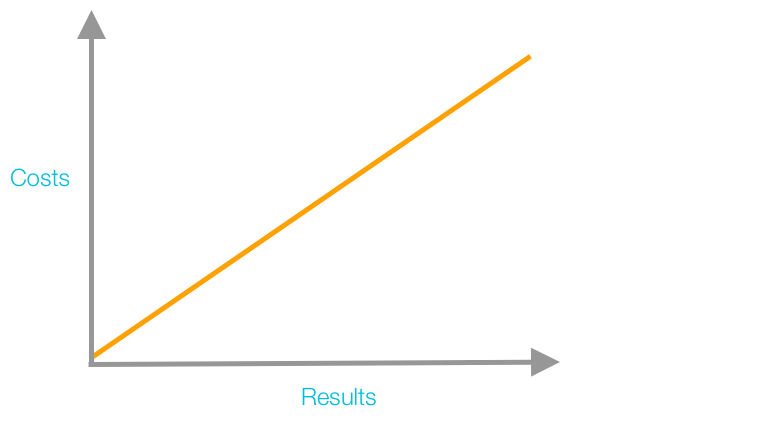
PPC Works Best for Commercial Intended Searches
PPC is good for the second search – or the later stage in your sales funnel.
PPC is good when someone conduct a commercial intent search query like “printer cartridges hp 8020”. When someone is conducting such a specific search, they already know what they want to have and is likely to purchase this cartridge – so the user is assumed to have a commercial intent.
When looking at the following screenshot of a search engine result page after conducting a search like this, you’ll see that its fundamental different from an informational intent search seen earlier in this article.
Most of the viewable area of this SERP is covered with transactional ads and the PPC ads begin right below the shopping ads. Just on the very bottom of the SERP you’ll see the first organic result – but this is a branded one, resulting from the brand keyword “hp” in your search query.
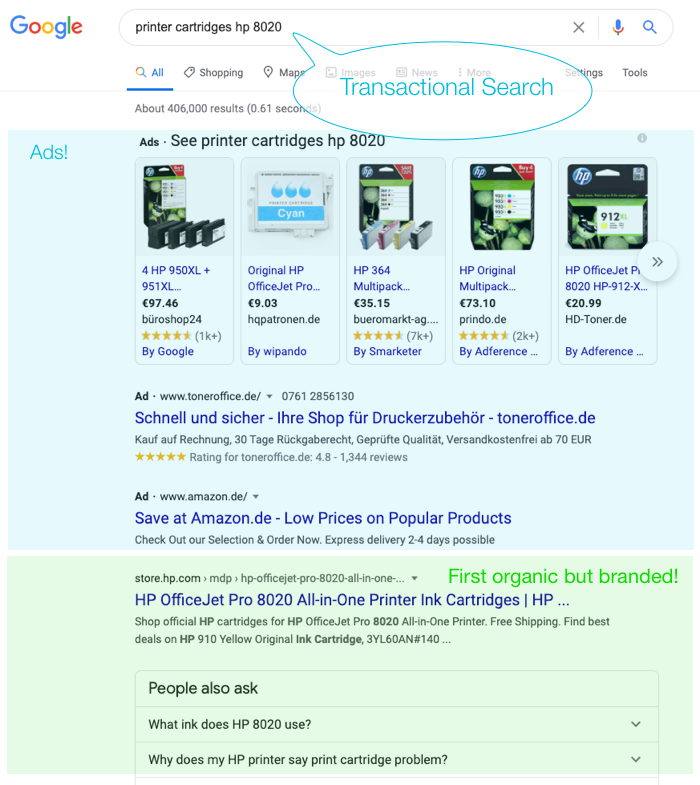
Here you can see that you might not rank organically for this search query in years, unless you’re HP. So this is the best way to use PPC instead of SEO 😉
Advantages with PPC
Position on the search engine result page: pay per click results dominate the SERPs and shows up above any organic result.
Improved Appearance: With PPC ads you have more control of their appearance and can style it per your wishes. Create an individual title as well as description text, create bullet points, site links, etc. just to name a few features that will enhance your marketing message.
Visibility: PPC gives you advantages on marketing your brand. Using the right (brand) keywords can greatly improve the visibility and reach of your brand and/or company.
Budget & Targeting: With SEO you have no deep control on how, when and where your marketing message is spread, PPC provides you with many options to enhance your results even more. You can determine the geography targets, day time, day of the week and many more to be used for your PPC ads. You can determine your budget, how much you want to spend per day and how much you want to spend per click.
Agility and Speed: SEO needs a longer time to run and changes might not shown up quickly. PPC gives you the ability to change your marketing message and the delivery of ads in just minutes.
Business Intelligence: Google doesn’t provide any keyword information from your organic traffic in Google Analytics. But it does provide keyword information about your PPC ads. Here you can measure which keywords bring the best conversion. You can optimize your PPC ads at any time.
Now What – SEO or PPC? Use Them Both!
Actually there is no either/or decision. It’s not about which you should use SEO or PPC but combining both in order to obtain a greatest search engine marketing (SEM) results.
Also you can use PPC ads to identify the best keywords for your business. Here you can prevent optimizing for the wrong keywords so you can save a lot of time on the already time consuming SEO.
When using SEO for pushing informational content, you might use PPC for transactional content that might enhance users visiting your informational page. Using this funnel strategy will greatly improve the conversion of your products and services.
See Think Do (and Care)
Use SEO and PPC within your sales funnel aligned to the See Think Do Care Framework. In the See phase a user might have a problem or a question in need of an answer. They will conduct a search like “My printer stops printing?” and may land on an informational content page in your website that has been optimized for organic search. This page might offer different reasons why a printer stops printing.
In the Think phase, the user is considering purchasing a new cartridge for his printer. The user might conduct a search like “Which cartridge is applicable for my HP printer?”. You may optimize a FAQ page that answers the question what cartridges are for which printers. You may also use some PPC ads as well to promote this page.
The Do phase represents users that definitely are in need to purchase something and looking actively for a specific item. Let’s say a user conducts a search like “Buy HP 912 cartridge”. This kind of product specific search queries most likely reflects a buying intention by the user. Using SEO to optimize a shopping page that sells this specific item is a very hard task and as you can see in the illustration earlier in this article.That’s the point where PPC pays off. Using these keywords with the right message in the ad and the right conversion optimized landing page will greatly improve the chance that a user buys the item they were looking for.
Conclusion: SEO + PPC = SEM
Good optimized content pages for the See and Think phases will help the user to make the right click on your PPC ads in the Do phase. That’s the power of SEM – using SEO and PPC together.
Use a company blog to setup a bunch of blogposts talking about topics that are of interest to your targeted audience in order to keep the user on your website. Use PPC with keywords that have commercial intent and are used in your blogpost as well to attract them again. Use retargeting techniques to them come back later.
What can you do?
There are some things you can do to answer the question on how to determine when to use SEO and PPC in your business:
- Understand your audience and what are their needs, problems and questions in their daily business
- Conduct research to find proper keywords with informational intent and use them in your blog articles, etc.
- Identify proper keywords with commercial intent that are appropriate to your products and services.
- Use Google Ads (formerly Ad Words) to identify the keywords that has low cost per click and considerable search volume. Set up a simple campaign with search ads for your most important products.
- Track the results using Google Analytics or an equivalent.
- Be patient 😉
- … or ask us if you need assistance!

